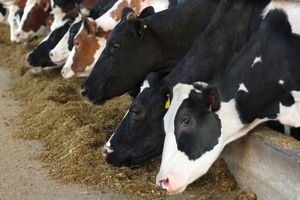5 Things to Know About Dairy Revenue Protection (DRP)
DRP keeps the glass full when unexpected revenue declines occur
 Got milk revenue loss coverage? If not, perhaps a tall glass of DRP is what you need in times like these.
Got milk revenue loss coverage? If not, perhaps a tall glass of DRP is what you need in times like these.
First launched by the U.S. Department of Agriculture (USDA) Risk Management Agency (RMA) in 2018, Dairy Revenue Protection is designed to insure dairy producers against unexpected declines in quarterly revenue from milk sales — relative to a guaranteed coverage level. It’s a flexible, easy-to-use policy that every dairy producer should consider given the volatility of the market today. With it still being a relatively new policy, however, some have questions of what it is and how it works.
Follow along as we outline 5 things to know about Dairy Revenue Protection.
1. DRP offers two revenue pricing options: Class Pricing and Component Pricing
The Class Pricing option uses Class III (milk for cheese/whey), Class IV milk (butter and milk powder) or a combination of both as a basis for determining coverage and indemnities. The Component Pricing option uses the component milk prices for butterfat, protein and other solids as a basis for determining coverage and indemnities. The butterfat test percentage and protein test percentage may be selected to establish the insured milk price.
“The intent of class pricing is to allow producers the opportunity to get close to what their actual price would be. Most producers tend to purchase based on their break-evens versus what their price would be,” said ProAg Western Region Senior District Sales Manager, Jacqueline Da Rocha. “Usually, with component pricing, insureds are milking Jersey cows, producing higher component levels. Component pricing is geared more for those herds producing higher component levels, while class pricing is used more for producers who are producing as much fluid milk as they can.”
2. Dairy producers have flexibility in the amount of coverage
Producers may cover up to 100% of their expected milk production by choosing coverage levels between 80-95% of the expected quarterly revenue in 5% increments. At the end of the insurance period, if the actual milk revenue is below the final revenue guarantee, the producer may receive an indemnity payment for the difference between the final revenue guarantee and the actual milk revenue multiplied times the share and protection factor.
“It is a risk management tool in your toolbox. You’re covering your bases so you can continue to do business,” Da Rocha noted.
3. The calculations are simple and straightforward
The revenue loss is calculated as the difference between the final revenue guarantee and actual milk revenue, times your actual share and protection factor. The covered milk production is indexed to the state or region where the dairy producer is located (DRP is approved for sale in every county in all 50 states).
“The expected revenue is based on futures prices for milk and dairy commodities and the amount of covered milk production elected by the dairy producer, respectively,” said Da Rocha. “Therefore, an important thing to note about DRP coverage is that markets change daily, similar to interest rates, making it a fluid coverage policy.”
4. There are exceptions to what is covered
The revenue loss needs to be caused by natural occurrences in market prices and yields in your state-level or pooled production region. DRP does not cover events such as death of dairy cattle, other loss or destruction of your dairy cattle, or any other loss or damage of any kind whatsoever.
5. Some changes to come for the 2023 crop year
Changes to note for next crop year include:
- Allowing sales to be suspended during the sales period for situations that arise during the sales period in which market conditions adversely change after the fact.
- Added flexibility to continue coverage when producers experience a disaster at their dairy operation. The insured can use the milk marketing records as of the date of the disaster to determine the milk produced for the rest of the insurance period or use prior milk marketing records if the disaster occurs prior to the start of the insurance period.
- Revised the policy to clarify that the termination date is June 30. Cancellation during a crop year to submit an application for another DRP policy with a different insurance provider within the same crop year is not allowed.
- Clarified that an insured cannot have other livestock insurance on the same milk in the same quarterly insurance period.
Get Dairy Revenue Protection today!
Insurance attaches the day a quarterly coverage endorsement is purchased, and multiple quarterly coverage endorsements may be purchased with one application. Talk to your ProAg insurance agent today and protect your dairy from the unexpected with Dairy Revenue Protection!
